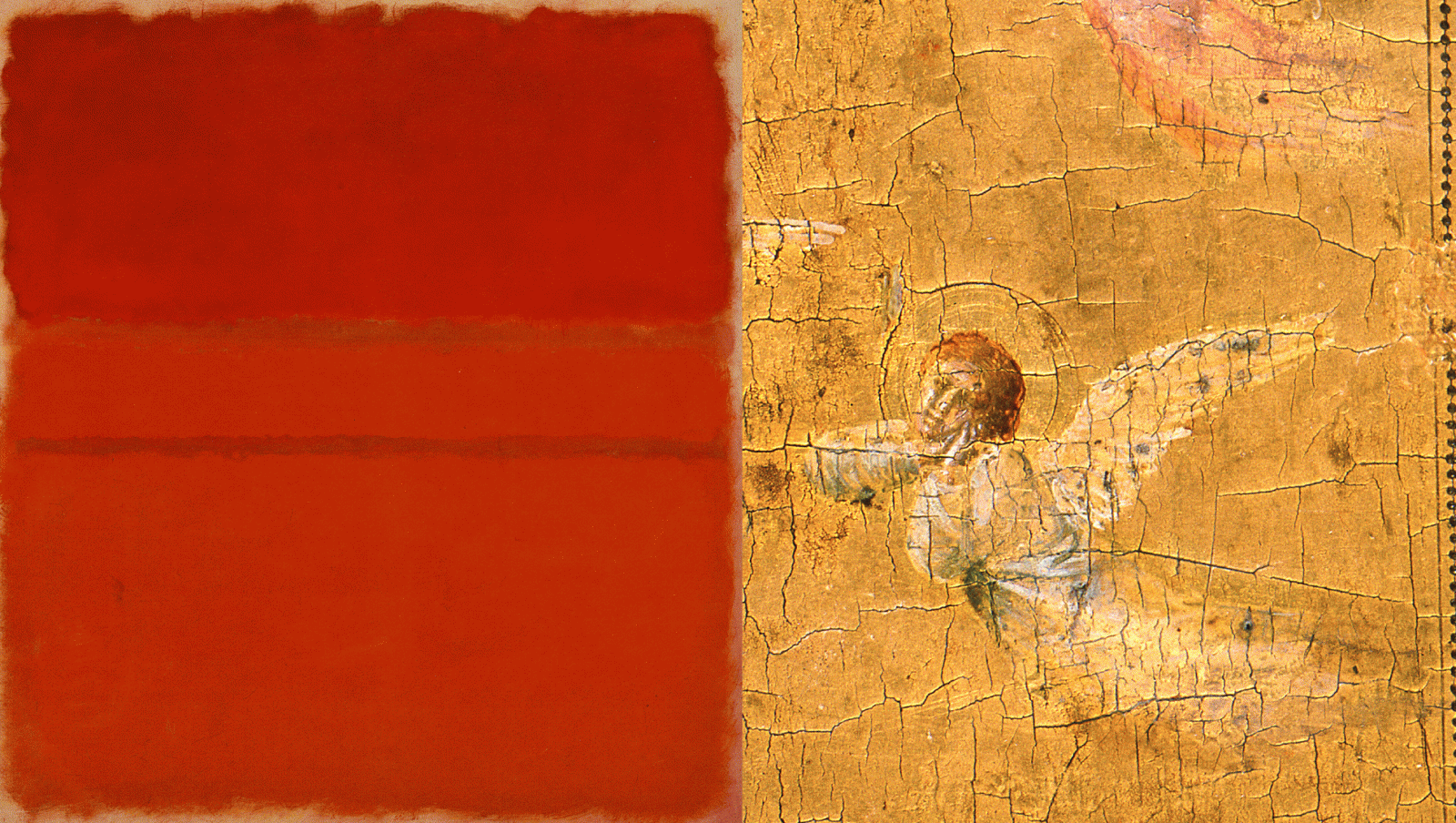Mostra
Rothko / Giotto - Tactility in Painting
An Exhibition of the Gemäldegalerie in cooperation with the Kunsthistorisches Institut in Florenz - Max-Planck-Institut and Daimler Contemporary, Berlin

Mark Rothko, Reds no. 5, 1961, Staatliche Museen zu Berlin, Neue Nationalgalerie / Giotto di Bondone, Kreuzigung Christi, ca. 1315, Staatliche Museen zu Berlin, Gemäldegalerie © VG Bildkunst Bonn, 2008, Foto: Volker-H. Schneider / © Staatliche Museen zu Berlin, Gemäldegalerie Foto: Jörg P. Anders
Mark Rothko (1903-1970) was one of the primary representatives of Abstract Expressionism of the New York School of Painting. His Color Field Paintings created from the 1950's on, and for which he is famous, are still celebrated today.
Throughout his life, Rothko dealt with philosophic, aesthetical and historiographical issues, by means of which he constantly redefined and questioned his own position as an artist. His ideas have recently been published in "The Artist's Reality" edited by his son Christopher Rothko, but written in the late 1930s. Rothko's thoughts, published in this text, as well as his later works, reveal his involvement with and examination of early Italian painting, particularly that by Giotto di Bondone (1264-1337). His numerous trips to Italy not only allowed him to admire the works of Giotto in situ, but also made him an enthusiast of Fra Angelico.
Regarding Giotto, Rothko was especially interested in his ability to organize space and action by means of color, exemplifying the concept of painted "tactility": Similarly to Giotto, who succeeded in rendering different materials as well as a whole range of human conditions in a tactile way, Rothko tried to intensify his constellations of colors which were to be experienced by the viewer as figurations of action and emotion. Throughout his life, Rothko insisted that he was not an abstract painter. He controlled the hanging of his works and referred to his paintings as "murals", analogical to the Italian technique of fresco painting. Rothko's involvement with medieval and Renaissance Italian works is the focus point of this exhibition. Thus, the presentation of his canvas "Reds no. 5" (Staatliche Museen zu Berlin, Nationalgalerie, 1961) alongside Giotto's large-sized "Death of the Virgin" (ca. 1310) and his "Crucifixion" (ca. 1315) is meant to lead the viewer to contemplate the relation between the two artists. The relationship between Renaissance and Modern art established in Rothko's thinking and painting is thus the main subject of the exhibition. At the same time, the exhibition space corresponds and relates to Rothko's artistic conception of space: Rothko imagined chapel-like spaces "in which the traveller or wayfarer could contemplate one detail of a painting hanging in a small room".
In 1957 he wrote: "I am interested only in expressing the basic human emotions - tragedy, ecstasy, doom, and so on […]. The people who weep before my pictures are having the same religious experience I had when I painted them."Mark Rothko (1903-1970) zählt zu den Hauptvertretern des abstrakten Expressionismus, innerhalb der so genannten "New York School". Ab den 1950er Jahren produzierte er seine "Color Field Paintings", mit denen er berühmt wurde.
Zeitlebens hat sich Rothko mit philosophischen, kunsttheoretischen und historiographischen Fragestellungen beschäftigt und damit den eigenen künstlerischen Standpunkt beständig neu bestimmt und hinterfragt. Erst unlängst wurden seine Gedanken unter dem Buchtitel "The Artist's Reality" durch seinen Sohn Christopher ediert. Rothko setzt sich in dieser Schrift, die in die späten 1930er Jahre datiert, aber auch in seinem späteren Werk mit der frühen italienischen Malerei auseinander, speziell mit der Bedeutung von Giotto di Bondone (1264-1337). Dazu reiste er auch mehrfach nach Italien, wo er nicht nur Giottos Schaffen im Original bewundern konnte, sondern auch zu einem Verehrer von Fra Angelico wurde.
An Giotto interessierte Rothko insbesondere die Fähigkeit, Bildraum und Handlung über das Kolorit zu organisieren. Das Konzept der "Berührbarkeit" (Taktilität, tactility) spielt dabei eine wesentliche Rolle: Wie es Giotto gelungen war, nicht nur unterschiedliche Materialitäten sondern auch das Spektrum menschlicher Konditionen greifbar zu inszenieren, so versuchte auch Rothko seine Farbkonstellationen zu verdichten, auf dass sie für den Betrachter zu bewegter Handlung, zu Erfahrungsräumen, würden. Zeitlebens bestand er darauf, dass seine Gemälde keine abstrakte Malerei darstellen. Vor diesem Hintergrund kontrollierte er sogar die Hängung seiner Werke und bezeichnete seine Bilder - analog zur italienischen Malerei a fresco - als "murals".
Ausgehend von diesem Blick des Malers auf die ältere Kunst Italiens, speziell jener des Mittelalters und der Renaissance, zeigt die Ausstellung Rothkos Leinwand "Reds no. 5" (Staatliche Museen zu Berlin, Nationalgalerie, 1961) zusammen mit zwei Hauptwerken Giottos, dem großen "Marientod" (ca. 1310) sowie einer "Kreuzigung" (ca. 1315). Visualisiert wird damit die Verbindung zwischen Renaissance und Moderne, die Rothko so intensiv bewegte. Zugleich entsteht ein Ausstellungsraum, der Rothkos eigenem Wunsch entspricht: der Maler träumte von Orten, die wie kleine Kapellen wirken, "in denen ein Reisender oder Wanderer eine Zeitlang ein einziges in einem kleinen Raum hängendes Bild"betrachten könne.
1957 hielt er fest: "Mich interessiert einzig der Ausdruck elementarer menschlicher Gefühle - Tragödie, Ekstase, Schicksal usw. […]. Jene Leute, die vor meinen Bildern weinen, machen dieselbe religiöse Erfahrung, die ich machte, als ich die Bilder malte."


